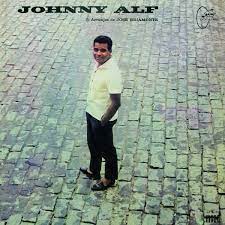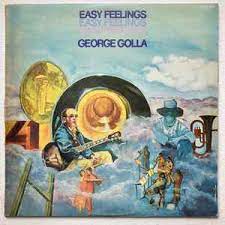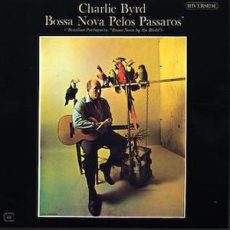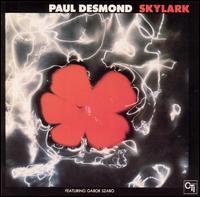
Daily Dose Of Jazz…
Johnny Alf was born Alfredo José da Silva on May 19, 1929 in Vila Isabel, Rio de Janeiro, Brazil and began playing piano at age 9. His father died when he was 3 and was raised by his mother, who worked as a maid to raise him. He attended Colégio Pedro II, receiving support from his mother’s employers who had appreciation for music. He was enrolled at the IBEU, Instituto Brasil-Estados Unidos, and it was there that he received his first formal musical training, studying classical piano with instructor Geni Bálsamo.
Influenced by Nat King Cole and George Sheaing, Frank Sinatra, Bing Crosby and Brazilian born Dick Fame, he eventually gained membership into the Sinatra~Farney Fan Club, a performers collective. Alf’s membership allowed him regular access to a piano as well as a group of musically sympathetic peers with which to play and experiment. They would finally get the payless opportunity to play in a few well known venues.
By 1950 he was pursuing a professional musical career and received his first professional break in 1952 when he was hired as the pianist at the newly inaugurated Cantina do César, owned by the popular radio host César de Alencar. With free musical reign. Johnny would receive frequent visits from pianist João Donato, vocalist Dolores Duran, and guitarist/vocalist João Gilberto who would sit in on the way to their gigs.
He would begin to combine Samba-cançãoes and foxtrots with American jazz styles. He would go on to record his first two albums, however, the recordings garnered no more than a pittance of recognition for Alf at the time, but would later in the early Sixties be hailed as the progenitors of the Bossa Nova style.
He continued to find nightly work in the Rio clubs and work with musical companions João Gilberto, João Donato, and the young pianist Antonio Carlos Jobim, all following him from venue to venue provided they could afford the cover fee. By 1954 he was performing regularly at the Hotel Plaza nightclub. Due to its haunted reputation Johnny was able to play his own compositions plus hold early evening jam sessions and these improvisatory collaborations that the harmonic and rhythmic structures eventually blossomed into the style now known as Bossa Nova.
Moving to Sao Paulo in 1955 he became the house pianist at a new club, Baiúca and formed a short-lived duo with double-bassist Sabá. Unfortunately the group only established a moderate following before Baiúca was closed down for health-code violations. In 1961 he declined the invitation to play at Carnegie Hall’s historic Bossa Nova Festival because he didn’t like the connotation bossa nova brought with it. That decision sent him towards obscurity and very little was heard from Alf, although he infrequently produce albums throughout the 60s and early 70s. He would continue to collaborate, record and perform to earn a living and eventually landed a position at a local conservatory of music.
Pianist, vocalist, composer and educator Johnny Alf, who is widely considered the Father of Bossa Nova, transitioned from complications caused by prostate cancer on March 4, 2010 in Santo Andre, just outside São Paulo, Brazil. This was his home for the last fifty years of his life. He left no immediate survivors.
More Posts: bandleader,club,history,instrumental,jazz,music,piano,vocal

Daily Dose Of Jazz…
George Golla was born May 10, 1935 in Chorzów, Poland. He emigrated to Australia in the 1950s and began working in Sydney from 1957. Two years later he commenced a long-term musical partnership with the clarinetist, flautist and saxophonist Don Burrows that continued for nearly forty years.
Recording frequently in duo, quartets and other combinations, they nurtured and featured many young talents, including brassman and multi-instrumentalist James Morrison, guitarist Guy Strazzullo, drummer David Jones and others.
As educators they taught at the New South Wales Conservatorium and Golla was a teacher at the Academy of Guitar in Bondi alongside Don Andrews. He specialized in jazz and classical guitar and has written several books on theory, scales and the modes.
George toured frequently throughout Australia, playing on-call with international artists such as vibraphonist Gary Burton in the early 1970s. He has had a long association with Luis Bonfa and other Brazilian musicians. He has made hundreds of recordings, including The Don Burrows Quartet at the Sydney Opera House, Cherry Pie 1017 & 1032, and Steph’n’Us, with Stephane Grappelli during a tour with Grappelli and Burrows.
Guitarist George Golla, at 85, continues to perform in and around Sydney with flugelhorn player and singer songwriter Elizabeth Geyer, and tours interstate and internationally, records and conducts workshops.
More Posts: bandleader,guitar,history,instrumental,jazz,music

Daily Dose Of Jazz…
William Frank Reichenbach Sr. was born on December 18, 1923 in Washington, D.C. and started his musical career even before he graduated from the McKinley Tech High School. During World War II, he played in a band of the Navy before he toured with the big bands of Tommy Dorsey, Jimmy Dorsey, and Art Mooney. Later he worked in the jazz clubs of his hometown, where he accompanied Frank Sinatra, Patti Page, Teddy Wilson, and Zoot Sims.
Charlie Byrd hired Reichenbach as an additional drummer for the Stan Getz album Jazz Samba, recorded in 1962. This recording provoked a wave of enthusiasm for bossa nova in the United States. That same year he replaced Buddy Deppenschmidt in the Byrd trio, and stayed as a member for twelve years. Departing from Byrd, he returned to work in Washington D.C., as the house drummer at the Blues Alley.
Drummer and percussionist Bill Reichenbach, who co-developed the jazz-samba drumming style, transitioned following a series of strokes in Los Angeles, California, at the age of 84 on May 16, 2008.
More Posts: bandleader,drums,history,instrumental,jazz,music,percussion

The Quarantined Jazz Voyager
This week while maintaining social distancing and continued mask wearing I’ve selected the 1974 album Skylark saxophonist Paul Desmond featuring Gábor Szabó. It was recorded on November 27~28 and December 4, 1973 at Van Gelder Sturio in Englewood Cliffs, New Jersey. The recording engineer was Rudy Van Gelder, the producer was Creed Taylor, and Don Sebesky wrote all the arrangements. It was released in 1974 on Taylor’s CTI label.
Desmond adapted to the changing times music was facing as did Taylor with his innovative photography used as his covers injected a sense of adventure, a bit of fantasy and a freedom that the 1970s exuded. It’s a change of pace for the saxophonist and a welcomed addition to the label’s stable.
Tracks |53:28- Take Ten (Paul Desmond) ~ 6:08
- Romance De Amor (Traditional) ~ 9:40
- Was A Sunny Day (Paul Simon) ~ 4:52
- Music For A While (Henry Purcell) ~ 6:45
- Skylark (Hoagy Carmichael, Johnny Mercer) ~ 5:21
- Indian Summer (Al Dubin, Victor Herbert) ~ 4:00
- Music For A While [alternate take] (Purcell) ~ 5:56
- Skylark” [alternate take] (Carmichael, Mercer) ~ 5:39
- Indian Summer” [alternate take] (Dubin, Herbert) ~ 5:27
- Paul Desmond ~ alto saxophone
- Bob James ~ piano, electric piano
- Gene Bertoncini ~ guitar
- Gábor Szabó ~ guitar (all solos)
- Ron Carter ~ bass
- Jack DeJohnette ~ drums
- Ralph MacDonald ~ percussion
- George Ricci ~ cello
More Posts: adventure,album,club,festival,genius,jazz,museum,music,preserving,restaurant,saxophone,travel

Daily Dose Of Jazz…
Douglas Anthony Munro was born July 9, 1953 in Yonkers, New York. He started his musical studies at age seven, taking drum lessons and by age fourteen, he was playing dances in Yonkers and New York City. At 20, he broke his back in a gymnastics accident, which ended his career as a drummer. However, in 1977 the 24 year old underwent a successful back surgery, and began playing guitar to pass the time during recovery
After his recovery he became a guitarist, performed locally and taught guitar lessons. In 1986 he released the LP Courageous Cats. and towards the end of the decade Doug met record producer Joe Ferry, and began a 25 year professional relationship. He would go on to divide his career into arranging, performing, teaching, and producing with Ferry. In 2004 he started a series of four Boogaloo recordings for Scufflin’ Records. The first, Boogaloo to Beck, featured Lonnie Smith, David “Fathead” Newman, and Lafrae Olivia Sci. He would go on to release to Brazilian jazz albums under the Big Boss Bossa Nova title.
The early Nineties saw Doug arranging and producing with Joe Ferry. Their first album, We Remember Pastorius, was a tribute to jazz bassist Jaco Pastorius. He would go on to co-produce and arrange a series of recordings for Shanachie Records. This period saw him delving into ska, receiving two Grammy nominations. In 1997 Munro added orchestrations to the original motion picture soundtrack for the Muhammad Ali documentary When We Were Kings which won the Academy Award for Best Documentary Film.
Munro continued to work on over 40 recording albums into the new millennium with Vitamin Records. He has produced lessons for Just Jazz Guitar, Premier Guitar, and TrueFire.com. He founded the jazz studies program in the Conservatory of Music at Purchase College in 1993, and served as the director of the program from 1993-2002. He retired in 2019 as Professor Emeritus and Director Emeritus of the Jazz Studies program at the Conservatory of Music at Purchase College.
Guitarist, arranger, producer, composer, author, and educator Doug Munro specializes in jazz, bebop, Brazilian jazz, jazz fusion, and gypsy swing. Since 1986 he has released over fifteen albums as a band leader and has appeared on over 75 recordings as a guitarist, sideman, producer, and arranger. He has been nominated for two Grammy Awards and was the recipient of two NAIRD Awards by the American Association of Independent Music.
More Posts: arranger,bandleader,composer,educator,guitar,history,instrumental,jazz,music,producer




